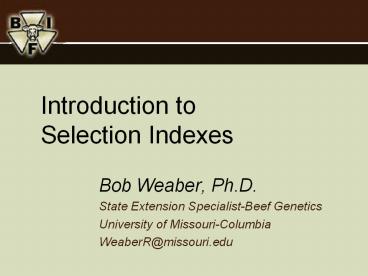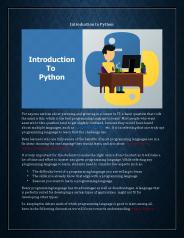Introduction to Selection Indexes - PowerPoint PPT Presentation
Title:
Introduction to Selection Indexes
Description:
37th BIF Annual Research Symposium and Meeting. 2. Seedstock. Cow-calf. Packer. Consumer ... Calf Survival. Weaning weight. Male/female Fertility. Longevity ... – PowerPoint PPT presentation
Number of Views:976
Avg rating:3.0/5.0
Title: Introduction to Selection Indexes
1
Introduction toSelection Indexes
- Bob Weaber, Ph.D.
- State Extension Specialist-Beef Genetics
- University of Missouri-Columbia
- WeaberR_at_missouri.edu
2
Seedstock
Communicate Value??
Cattle
Information
Cow-calf
Feeder
Packer
Consumer
3
Overview
- What are selection indexes?
- Defined
- The Breeding Objective
- Traits vs. Characteristics
- Relative Economic Values
- Why do we need selection indexes?
- Multiple trait selection
- What are their limitations?
4
What Is a Selection Index?
- Selection on aggregate merit (Hazel, 1943)
- List of traits that influence satisfaction
- Relative Economic Value (REV) of each trait
- Increase in satisfaction with one unit change in
a trait, all others held constant - List of characteristics to be measured on animal
- Relationships between characteristics
(phenotypes) and traits (genotypes)
5
Selection Index Defined
- Two Step approach by Henderson (1950s)
- Calculate predictions of genetic merit (EPD) for
each trait in selection objective - Weight each genetic prediction by its Relative
Economic Value (REV) - Equivalent to Hazel approach
6
Breeding Objective
- Traits inSelection Index
- CE EPD
- WW EPD
- YW EPD
- Milk EPD
- Heifer Pregnancy EPD
- Stayability EPD
- CharacteristicsIn Breeding Objective
- Calf Survival
- Weaning weight
- Male/female Fertility
- Longevity
- Milk production
- Feed efficiency
7
Why Do We Need Selection Indexes?
- There is no easily accessible, objective way
for breeders, particularly breeders in the beef
and sheep industries where ownership is diverse
and production environments vary a great deal, to
use these predictions intelligently. -- R.
M. Bourdon, 1998
8
Why is multiple trait selection..
- Difficult?
- Lots of EPDs
- Some for Economically Relevant Trait (ERT) some
for Indicator Traits - Relative economic importance of traits given
breeding/marketing/endpoint - Ability to construct a meaningful profit function
- Important?
- More than one trait is important for enterprise,
operation or industry profitability
9
Tools for Multiple Trait Selection
- Independent Culling Levels
- Too cumbersome
- Inefficient in generating response to selection
- Economics sketchyseat of pants approach
- Selection Indexes
- Objective
- Easy to use and interpret ()
- Economically driven
- REVs from bio-economic simulation
- Links ERTs and Indicator Traits
- Customizable (Site/user specific)
10
Selection Index Limitations
- EPD not available on all ERTs or Indicators
- Most indexes revenue focused cost information
difficult to obtain - General Indexes representative of industry vs.
Custom Index representative of individual firm - Relative Economic Values used in generalized
index may not be reflective of your operation - Linear vs. Non-linear Profit Functions
- Diminishing returns (i.e. Carcass Wt., Mature
Size) - Managerial differences can cause contraction or
expansion of phenotypic variation - Still better than seat of pants approach that
most of us apply
11
Thank You!
12
Literature Cited
- Bourden, R. M. 1998. Shortcomings of current
genetic evaluation systems. J. Anim. Sci.
762308-2323 - Golden, B. L., D. J. Garrick, S. Newman, and R.
M. Enns. 2000. Economically Relevant Traits A
Framework for the Next Generation of EPDs. Proc.
32nd Annual Research Symposium and Annual
Meeting, Beef Improvement Federation, Witchita,
Kansas. - Harris, D. L. 1998. Livestock improvement Art,
Science, or Industry? J. Anim. Sci. 762294-2302 - Harris, D. L. and S. Newman. 1994. Breeding for
profit Synergism between genetic improvement and
livestock production (a review). J. Anim. Sci.
722178-2200 - Hazel, L. N. 1943. The genetic basis for
constructing selection indexes. Genetics
28476-490. - Hazel L. N. and J. L. Lush. 1943. The efficiency
of three methods of selection. Journ. Hered.
33393-399. - Hazel, L. N., G. E. Dickerson, and A. E. Freeman.
1994. The selection index Then, Now, and for the
future. J. Dairy Sci. 773236-3251 - Henderson, C. R. 1951. Mimeo published by Cornell
University. Ithaca, NY. - Henderson, C. R. 1963. Selection index and
expected genetic advance. In Statistical
Genetics and Plant Breeding. Natnl. Acad. Sci.
Natnl. Res. Counc. Publ. 982. pp. 141-163.
National Academy of Science, Washington, DC. - MacNeil, M. D. 2003. Genetic evaluation of an
index of birth weight and yearling weight to
improve efficiency of beef production. J. Anim.
Sci. 8124252433 - Schneeberger, M., S. A. Barwick, G. H. Crow, and
K. Hammond. 1992. Economic indices using breeding
values predicted by BLUP. J. Anim. Breed. Genet.
109180.































